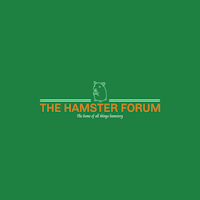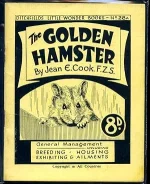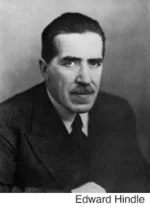- Messages
- 21,181
- Reaction score
- 38,275
- Points
- 1,373
There's a very interesting article on the archived web page of the former British Hamster Association. I've linked the article below and the information in it is from an early book called "Hamster Guidance" by Jean E Cook - published around 1960 (but talking about 1948 period). It says the foreward of the book was written by Edward Hindle Sc.D, FSS - it says (probably incorrectly), that Hindle received the first pair of hamsters from Syria. In fact Hindle was given some Hamsters by Saul Adler (who brought them into the Uk) - see the post below - but Hindle was instrumental in Hamsters becoming available on the pet market.

 www.thehamsterforum.com
www.thehamsterforum.com
Hamsters didn't eat as well as they do now Food rationing continued for some years after WWII and apparently it was illegal to give human grade food to animals.
Food rationing continued for some years after WWII and apparently it was illegal to give human grade food to animals.
"... at that time there were no special hamster mixes and by law no foods suitable for human consumption might be fed to animals whilst food rationing, including bread, was still in force. The basic food was Spratt's Cat food with added vegetables and household scraps.This was made into a mash and and moistened with goat's milk or gravy. As this might be deficient in fat and minerals it was advised that one teaspoonful of cod liver oil for every 25 hamsters be added twice a week and a little salt and limestone also included. For extra protein and variety it was suggested that worms or caterpillars be given and also that acorns and blackberries would be enjoyed. Expectant females should have bone meal and cod liver oil added to the mash daily as well as goat's milk available."
It seems hamsters survived on this combination of cat food, goat's milk, gravy and cod liver oil and a bit of veg! It's hard to imagine them eating caterpillars. But perhaps the diet was ok. It sounds lacking in grains however.
It also mentions the type of hamsters cages used in the 1940s initially which sound pretty bad - a wood box with a bit of mesh.
The book the food information is taken from doesn't seem to be in print any more, but I found it on a vintage book selling site (mainly sells antique books). Notably it cost 8d (that is eight old pennies), less than a shilling, which was 12d (a shilling became 5 new pence or the 5p piece).

This is the Edward Hindle referred to - he was a zoologist.
 en.wikipedia.org
en.wikipedia.org
The wikipedia article doesn't mention his involvement with hamsters but does mention his time at the Hunterian Museum, and the Hunterian Museum web page has informed about his involvement with Hamsters.
"He is also well known for the introduction of the golden hamster into the home and the laboratory."
This article quotes an introduction to another booklet, written by Edward Hindle who said
A photo of Edward Hindle (from this site)

 zoologyweblog.blogspot.com
zoologyweblog.blogspot.com

The article also has information about Hamsters brought to the Uk by James Skerne in 1879 (mentioned in the wheel history post so I'll add it there too).

 zoologyweblog.blogspot.com
zoologyweblog.blogspot.com

The History of the Syrian Hamster
Naturalists first catalogued the Syrian Hamster (Mesocricetus auratus) in the late 1700s. In the 1930s, medical researchers first obtained Syrian hamsters and further domestication led to the Hamster becoming a pet. Their natural habitat is a small region of Northwest Syria near the city of...
 www.thehamsterforum.com
www.thehamsterforum.com
Hamsters didn't eat as well as they do now
"... at that time there were no special hamster mixes and by law no foods suitable for human consumption might be fed to animals whilst food rationing, including bread, was still in force. The basic food was Spratt's Cat food with added vegetables and household scraps.This was made into a mash and and moistened with goat's milk or gravy. As this might be deficient in fat and minerals it was advised that one teaspoonful of cod liver oil for every 25 hamsters be added twice a week and a little salt and limestone also included. For extra protein and variety it was suggested that worms or caterpillars be given and also that acorns and blackberries would be enjoyed. Expectant females should have bone meal and cod liver oil added to the mash daily as well as goat's milk available."
It seems hamsters survived on this combination of cat food, goat's milk, gravy and cod liver oil and a bit of veg! It's hard to imagine them eating caterpillars. But perhaps the diet was ok. It sounds lacking in grains however.
It also mentions the type of hamsters cages used in the 1940s initially which sound pretty bad - a wood box with a bit of mesh.
The book the food information is taken from doesn't seem to be in print any more, but I found it on a vintage book selling site (mainly sells antique books). Notably it cost 8d (that is eight old pennies), less than a shilling, which was 12d (a shilling became 5 new pence or the 5p piece).

The Golden Hamster | General Management Including Breeding, Housing, Exhibiting and Ailments [Ditchfield's Little Wonder Books Series No. 28A] by Cook, Jean E. [Frank Ditchfield | Ditchfield British Books Ltd.] Once T. W. Pond: (1960) | Little Stour
Published by Frank Ditchfield 65 Albert Street, Regent's Park, London | 161 Morrison Street, Edinburgh circa . - 1960 - Condition: Very Good - Publisher's original wire stitched illustrated paper wrap covers [soft back] 12mo 5¼'' x 4¼''. Contains 32 pp + covers with monochrome text...
www.abebooks.com
This is the Edward Hindle referred to - he was a zoologist.
Edward Hindle - Wikipedia
The wikipedia article doesn't mention his involvement with hamsters but does mention his time at the Hunterian Museum, and the Hunterian Museum web page has informed about his involvement with Hamsters.
"He is also well known for the introduction of the golden hamster into the home and the laboratory."
This article quotes an introduction to another booklet, written by Edward Hindle who said
I received two pairs of these animals from Dr. S. Adler in the following year, and built up a stock maintained first at Hampstead and subsequently in my department at the University of Glasgow From the outset I had no difficulty in breeding them and was able to distribute specimens to any one interested. The London Zoological Gardens received a few pairs shortly before the war, which bred so prolifically that they were put on sale, and helped to make the Golden Hamster known to a much wider public.
Their rapid increase in general popularity dates from the end of the war and now they seem to have become thoroughly established as a domestic pet.
A photo of Edward Hindle (from this site)

History of the Golden Hamster: 2. Syria, Palestine and London
In 1985 Michael Ross Murphy (1945-2018) wrote an account of the capture and domestication of the Golden Hamster. All hamsters of this speci...

The article also has information about Hamsters brought to the Uk by James Skerne in 1879 (mentioned in the wheel history post so I'll add it there too).

History of the Golden Hamster: 6. Golden Hamsters kept in Scotland at the turn of the 20th Century
All the captive Golden Hamsters up to the 1970s were descended from a single litter collected by Israel Aharoni near Aleppo in 1930. That s...
Last edited:
